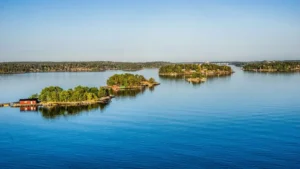The Yamuna River, one of India’s major rivers, originates from the Yamunotri Glacier in the Himalayas. Flowing through several states including Uttarakhand, Haryana, and Uttar Pradesh, it is revered in Hinduism and holds cultural significance. However, it faces severe pollution challenges due to industrial waste and sewage discharge, impacting both ecosystems and human health. Efforts to clean and rejuvenate the Yamuna remain ongoing.
Origin of the Yamuna River
The Yamuna River originates from the Yamunotri Glacier in the Uttarkashi district of Uttarakhand, India. Nestled in the southwest slopes of the Banderpooch peaks at an elevation of 6,387 meters (20,955 feet), the river’s source is considered one of the holiest Hindu sites. The Yamunotri Temple, dedicated to the goddess Yamuna, is a significant stop on the Chota Char Dham Yatra route, attracting numerous pilgrims.
Length of the Yamuna River
Stretching 1,376 kilometers exclusively within India, the Yamuna River courses through three states: Uttarakhand, Uttar Pradesh, and Haryana. Its meandering journey encompasses diverse landscapes, from the pristine heights of the Uttarakhand Himalayas to the fertile plains of Uttar Pradesh and Haryana. As it flows, the Yamuna sustains livelihoods, cultures, and ecosystems along its banks, embodying the essence of India’s rich river heritage.
Tributaries of the Yamuna River
The Yamuna River has several tributaries contributing to its flow:
- Left Bank: Hindon, Tons, Hanuman Ganga, Sasur Khaderi
- Right Bank: Giri, Baghain, Sabi, Chambal, Betwa, Sindh, Ken
Among these, the Chambal River is the longest tributary, possessing a significant basin of its own.
Course and Major Cities
Flowing through multiple states, the Yamuna River traverses Uttarakhand, Himachal Pradesh, Uttar Pradesh, Haryana, and Delhi. Key cities along its banks include:
- Haryana: Yamuna Nagar
- Delhi: New Delhi
- Uttar Pradesh: Noida, Mathura, Agra, Firozabad, Etawah, Auraiya, and Prayagraj (Allahabad)
The river’s journey culminates as it merges with the Ganges at Prayagraj, Uttar Pradesh, forming the Sangam, a revered site for Hindu rituals and festivals.
Catchment Area of the Yamuna River
The Yamuna River’s catchment area spans several states, delineating state borders between Himachal Pradesh and Uttarakhand, as well as Haryana, Delhi, and Uttar Pradesh. The catchment area is distributed as follows:
- Uttar Pradesh and Uttarakhand: 74,208 km²
- Himachal Pradesh: 5,799 km²
- Haryana: 21,265 km²
- Rajasthan: 102,883 km²
- Madhya Pradesh: 140,230 km²
- Delhi: 1,485 km²
Cultural and Economic Significance of Yamuna River
The Yamuna River holds immense cultural and religious significance in India, being central to numerous Hindu rituals and festivals. Economically, it supports agriculture, provides water for irrigation, and sustains millions of people living in its basin. The river’s banks host several historical and cultural landmarks, including the iconic Taj Mahal in Agra.




 Top and Bottom 10 Countries in the Globa...
Top and Bottom 10 Countries in the Globa...
 Which Country has the Highest Number of ...
Which Country has the Highest Number of ...
 Which was the First Country to Start Chr...
Which was the First Country to Start Chr...







